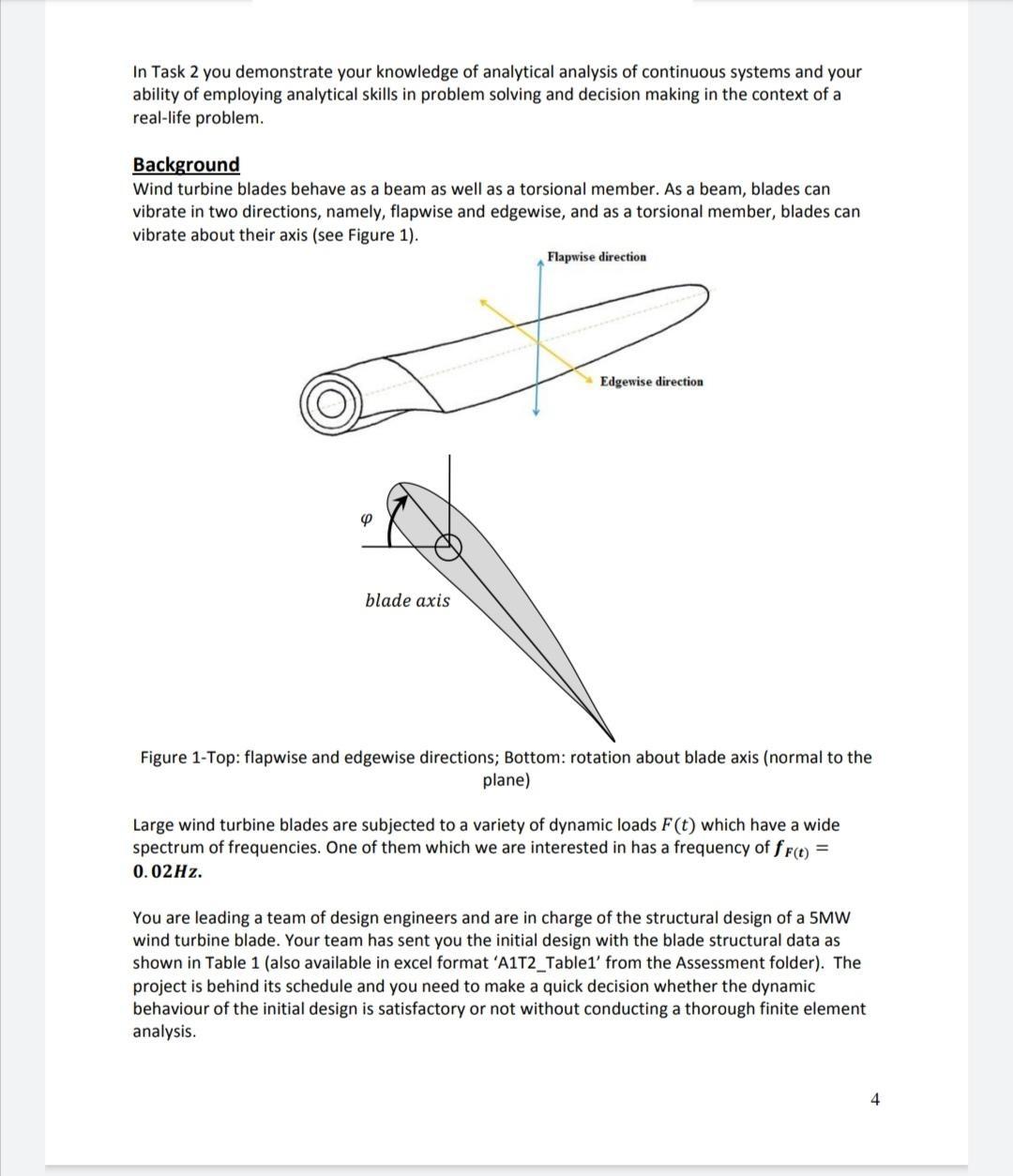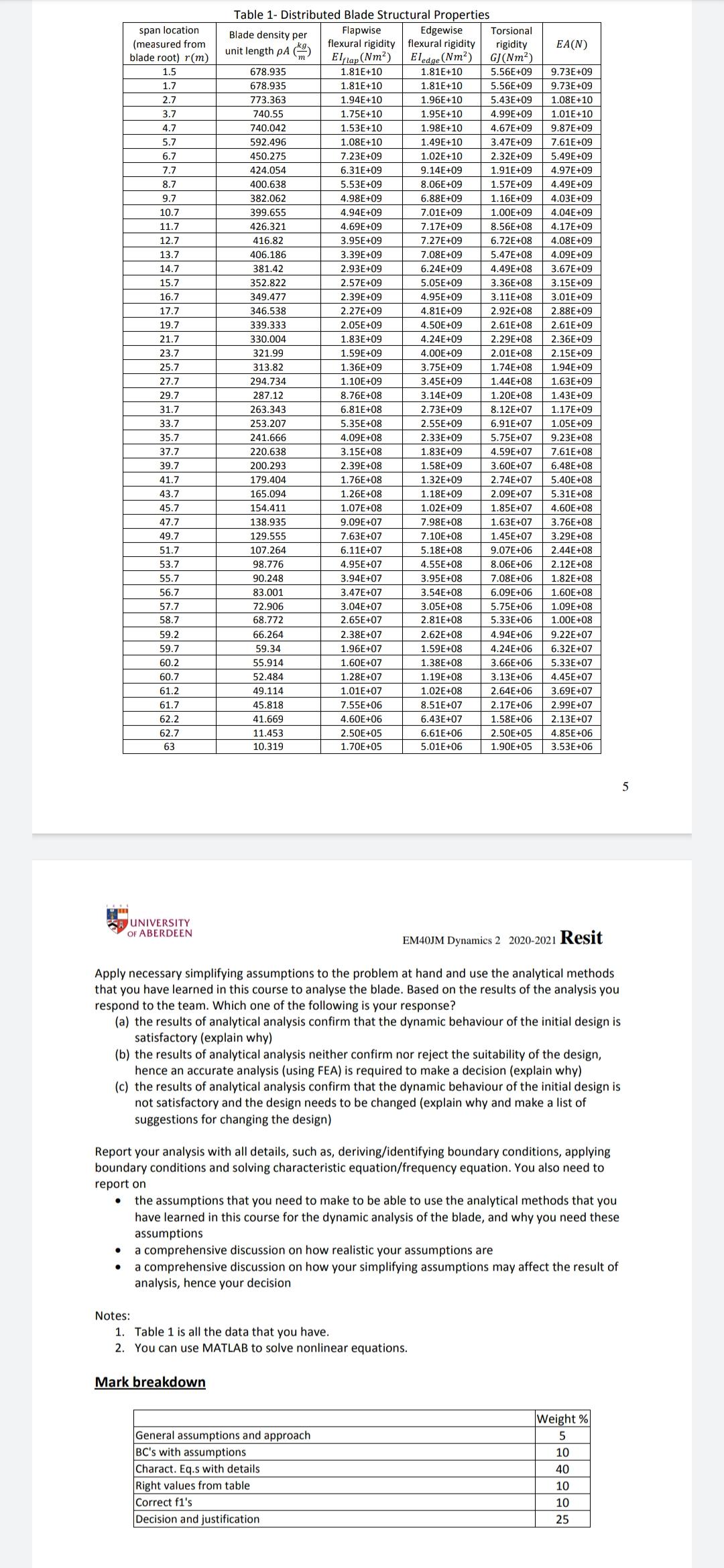Answered step by step
Verified Expert Solution
Question
1 Approved Answer
In Task 2 you demonstrate your knowledge of analytical analysis of continuous systems and your ability of employing analytical skills in problem solving and


In Task 2 you demonstrate your knowledge of analytical analysis of continuous systems and your ability of employing analytical skills in problem solving and decision making in the context of a real-life problem. Background Wind turbine blades behave as a beam as well as a torsional member. As a beam, blades can vibrate in two directions, namely, flapwise and edgewise, and as a torsional member, blades can vibrate about their axis (see Figure 1). 4 blade axis Flapwise direction Edgewise direction Figure 1-Top: flapwise and edgewise directions; Bottom: rotation about blade axis (normal to the plane) Large wind turbine blades are subjected to a variety of dynamic loads F(t) which have a wide spectrum of frequencies. One of them which we are interested in has a frequency of fF(t) = 0.02Hz. You are leading a team of design engineers and are in charge of the structural design of a 5MW wind turbine blade. Your team has sent you the initial design with the blade structural data as shown in Table 1 (also available in excel format A1T2_Table1 from the Assessment folder). The project is behind its schedule and you need to make a quick decision whether the dynamic behaviour of the initial design is satisfactory or not without conducting a thorough finite element analysis. 4 span location (measured from blade root) r(m) 1.5 1.7 2.7 3.7 4.7 5.7 6.7 7.7 8.7 9.7 10.7 11.7 12.7 13.7 14.7 15.7 16.7 17.7 19.7 21.7 23.7 25.7 27.7 29.7 31.7 33.7 35.7 37.7 39.7 41.7 43.7 45.7 47.7 49.7 51.7 53.7 55.7 56.7 57.7 58.7 59.2 59.7 60.2 60.7 61.2 61.7 62.2 62.7 63 UNIVERSITY OF ABERDEEN Table 1- Distributed Blade Structural Properties Flapwise flexural rigidity Elflap (Nm) Blade density per unit length pA ( 678.935 678.935 773.363 740.55 740.042 592.496 450.275 424.054 400.638 382.062 399.655 426.321 416.82 406.186 381.42 352.822 349.477 346.538 339.333 330.004 321.99 313.82 294.734 287.12 263.343 253.207 241.666 220.638 200.293 179.404 165.094 154.411 138.935 129.555 107.264 98.776 90.248 83.001 Mark breakdown 72.906 68.772 66.264 59.34 55.914 52.484 49.114 45.818 41.669 11.453 10.319 1.81E+10 1.81E+10 1.94E+10 1.75E+10 1.53E+10 1.08E+10 7.23E+09 6.31E+09 5.53E+09 4.98E+09 4.94E+09 4.69E+09 3.95E+09 3.39E+09 2.93E+09 2.57E+09 2.39E+09 2.27E+09 2.05E+09 1.83E+09 1.59E+09 1.36E+09 1.10E+09 8.76E+08 6.81E+08 5.35E+08 4.09E+08 3.15E+08 2.39E+08 1.76E+08 1.26E+08 1.07E+08 9.09E+07 7.63E+07 6.11E+07 4.95E+07 3.94E+07 3.47E+07 3.04E+07 2.65E+07 2.38E+07 1.96E+07 1.60E+07 1.28E+07 1.01E+07 7.55E+06 4.60E+06 2.50E+05 1.70E+05 Edgewise flexural rigidity Eledge (Nm) General assumptions and approach BC s with assumptions Charact. Eq.s with details Right values from table Correct f1 s Decision and justification 1.81E+10 1.81E+10 1.96E+10 1.95E+10 1.98E+10 1.49E+10 1.02E+10 9.14E+09 8.06E+09 6.88E+09 7.01E+09 7.17E+09 7.27E+09 7.08E+09 6.24E+09 5.05E+09 4.95E+09 4.81E+09 4.50E+09 4.24E+09 4.00E+09 3.75E+09 3.45E+09 3.14E+09 2.73E+09 2.55E+09 2.33E+09 1.83E+09 1.58E+09 1.32E+09 1.18E+09 1.02E+09 7.98E+08 7.10E+08 5.18E+08 4.55E+08 3.95E+08 3.54E+08 3.05E+08 2.81E+08 2.62E+08 1.59E+08 1.38E+08 1.19E+08 1.02E+08 8.51E+07 6.43E+07 6.61E+06 5.01E+06 Notes: 1. Table 1 is all the data that you have. 2. You can use MATLAB to solve nonlinear equations. Torsional rigidity GJ (Nm) 5.56E+09 9.73E+09 5.56E+09 9.73E+09 5.43E+09 1.08E+10 4.99E+09 1.01E+10 4.67E+09 9.87E+09 3.47E+09 7.61E+09 2.32E+09 5.49E+09 1.91E+09 4.97E+09 1.57E+09 4.49E+09 1.16E+09 4.03E+09 EA(N) EM40JM Dynamics 2 2020-2021 Resit Apply necessary simplifying assumptions to the problem at hand and use the analytical methods that you have learned in this course to analyse the blade. Based on the results of the analysis you respond to the team. Which one of the following is your response? (a) the results of analytical analysis confirm that the dynamic behaviour of the initial design is satisfactory (explain why) 1.00E+09 4.04E+09 8.56E+08 4.17E+09 6.72E+08 4.08E+09 5.47E+08 4.09E+09 4.49E+08 3.67E+09 3.36E+08 3.15E+09 3.11E+08 3.01E+09 2.92E+08 2.88E+09 2.61E+08 2.61E+09 2.29E+08 2.36E+09 2.01E+08 2.15E+09 1.74E+08 1.94E+09 1.44E+08 1.63E+09 1.20E+08 1.43E+09 8.12E+07 1.17E+09 6.91E+07 1.05E+09 5.75E+07 9.23E+08 4.59E+07 7.61E+08 3.60E+07 6.48E+08 2.74E+07 5.40E+08 2.09E+07 5.31E+08 1.85E+07 4.60E+08 1.63E+07 3.76E+08 1.45E+07 3.29E+08 9.07E+06 2.44E+08 8.06E+06 2.12E+08 7.08E+06 1.82E+08 6.09E+06 1.60E+08 5.75E+06 1.09E+08 5.33E+06 1.00E+08 (b) the results of analytical analysis neither confirm nor reject the suitability of the design, hence an accurate analysis (using FEA) is required to make a decision (explain why) (c) the results of analytical analysis confirm that the dynamic behaviour of the initial design is not satisfactory and the design needs to be changed (explain why and make a list of suggestions for changing the design) 4.94E+06 9.22E+07 4.24E+06 6.32E+07 3.66E+06 5.33E+07 3.13E+06 4.45E+07 2.64E+06 3.69E+07 2.17E+06 2.99E+07 1.58E+06 2.13E+07 2.50E+05 4.85E+06 1.90E+05 3.53E+06 Report your analysis with all details, such as, deriving/identifying boundary conditions, applying boundary conditions and solving characteristic equation/frequency equation. You also need to report on the assumptions that you need to make to be able to use the analytical methods that you have learned in this course for the dynamic analysis of the blade, and why you need these assumptions a comprehensive discussion on how realistic your assumptions are a comprehensive discussion on how your simplifying assumptions may affect the result of analysis, hence your decision Weight % 5 10 40 10 10 25 5
Step by Step Solution
★★★★★
3.44 Rating (144 Votes )
There are 3 Steps involved in it
Step: 1

Get Instant Access to Expert-Tailored Solutions
See step-by-step solutions with expert insights and AI powered tools for academic success
Step: 2

Step: 3

Document Format ( 2 attachments)
60d5e1d225685_226036.pdf
180 KBs PDF File
60d5e1d225685_226036.docx
120 KBs Word File
Ace Your Homework with AI
Get the answers you need in no time with our AI-driven, step-by-step assistance
Get Started


